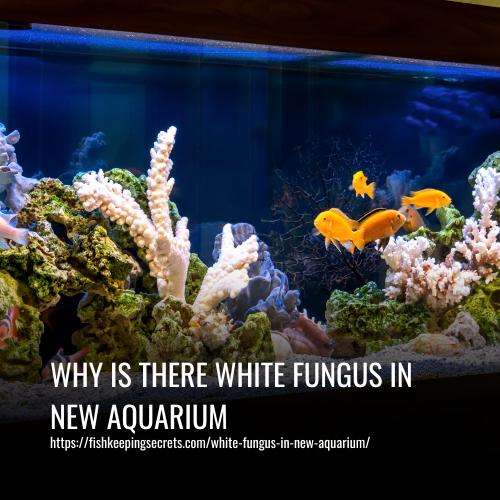White fungus growth is a common issue that many aquarists encounter while setting up a new aquarium. It can be persistent and difficult to remove once it appears in your tank. However, the reason behind its occurrence can vary due to various factors.
Here are some possible reasons why your new aquarium may have white fungus:
- Dirty Substrate.
- High Levels of Ammonia.
- Dirty Driftwood.
- Dirty Plants.
- Dirty Aquarium Decors.
- Uncycled Water.

1. Dirty Substrate:
When starting a new aquarium, one of the biggest concerns is the presence of white fungus. Although most substrates are washed before being sold, they can still carry fungus spores due to their dusty nature. This is why it’s important to clean the new substrate thoroughly before adding it to the tank. By doing so, you’ll remove any dirt and dust that could contain fungus spores and prevent white fungus from appearing in your aquarium.
2. High Levels of Ammonia:
High levels of ammonia during the setup of a new aquarium can be attributed to insufficient beneficial bacteria in the water. These bacteria are crucial in converting ammonia and nitrites into harmless nitrogen compounds, ensuring water safety.
When the ammonia levels remain high in a new tank, it creates the perfect environment for white fungus to grow on the bottom. Fortunately, with proper care and attention, this issue can be resolved quickly to create a healthy and thriving environment for your aquatic pets.
3. Dirty Driftwood:
If you’re planning to include driftwood in your aquarium, it’s essential to clean it thoroughly beforehand. That’s because driftwood may contain fungus spores that can cause white fungus to grow in your tank. To start cleaning, scrub away any dirt on the wood’s surface. However, this may not be enough to fully eliminate the threat of fungus.
A suggestion for ensuring safety is to soak the driftwood in boiling water for 1-2 hours before adding it to the aquarium. This can help kill any remaining spores on the wood, preventing any potential growth of white fungus in your new aquarium.
4. Dirty Plants:
When setting up a new aquarium, it’s common to encounter white fungus growth. One of the reasons this happens is due to fungus spores that may have been brought in by plants. These spores can cling onto leaves and other surfaces and begin spreading in the new environment.
To prevent this situation from occurring, it’s recommended to inspect any plants before introducing them into your aquarium. It’s also essential to regularly trim off any rotting or dying leaves from these plants, as they can encourage fungus growth over time.
5. Dirty Aquarium Decors:
The decorations you choose to put in your aquarium play an important role in its overall appearance. However, if they are not properly cleaned, they can introduce harmful substances such as fungus into your tank. In fact, fungus spores can easily attach themselves to the decorations and grow once placed in the new environment.
Before putting any decorations into your fish tank, it is crucial to give them a thorough cleaning to ensure that no dirt or other unwanted substances linger on their surfaces. This simple step can help prevent problems such as white fungus from appearing in your new aquarium.
6. Uncycled Water:
If you’re seeing white fungus in your new aquarium, the most likely reason is that the water hasn’t gone through the cycling process yet. It’s essential to wait at least one week for the water to cycle and establish a good bacteria colony necessary for converting ammonia into less harmful substances.
When there isn’t enough of this bacteria, ammonia levels can spike and create an environment where fungi can thrive. To avoid this issue, always make sure to properly cycle your aquarium before adding fish or other aquatic creatures.
FAQs
The white fungus you’re seeing is likely a common occurrence in new aquarium setups known as “new tank syndrome.” It’s caused by an imbalance in the tank’s ecosystem, often due to excess nutrients or organic matter. This fungus typically appears as a result of the decomposition process of uneaten fish food, decaying plant matter, or other organic debris in the tank.
Generally, the white fungus itself is not harmful to fish. However, it can indicate poor water quality, which can be harmful to fish if left untreated. It’s essential to address the underlying causes of the fungus, such as excess nutrients or inadequate filtration, to ensure a healthy environment for your fish.
To remove the white fungus, perform regular water changes to improve water quality and remove excess nutrients. Additionally, ensure proper filtration and circulation in the tank to prevent organic matter from accumulating. You can also manually remove visible fungus and debris during water changes or with a gentle aquarium vacuum.
Adding fish to a new aquarium with white fungus may not necessarily resolve the issue and can even exacerbate it if the tank is not fully cycled. It’s crucial to establish a stable nitrogen cycle in the tank before adding fish, as this process helps break down waste and maintain water quality.
The duration of the white fungus in a new aquarium can vary depending on the underlying causes and how quickly they are addressed. With proper maintenance and water quality management, the fungus typically diminishes within a few weeks as the tank matures and stabilizes.
While there are chemical treatments available to address fungal issues in aquariums, they are not always necessary and can potentially harm fish and other aquatic life if used incorrectly. It’s generally recommended to focus on natural methods such as improving water quality through regular maintenance and establishing a healthy aquarium ecosystem. If chemical treatments are deemed necessary, carefully follow dosage instructions and consider temporary removal of fish during treatment.
Conclusion:
While finding white fungus in your new aquarium may be concerning, it’s actually a sign of a healthy and thriving ecosystem. This fungus plays an important role in breaking down waste and helping to maintain water quality. So, instead of panicking, embrace the white fungus as a natural part of the aquarium’s ecosystem.
Just remember to monitor the water parameters and provide proper care for your aquatic friends. So, go ahead and enjoy the beauty and uniqueness that the white fungus brings to your underwater world!



